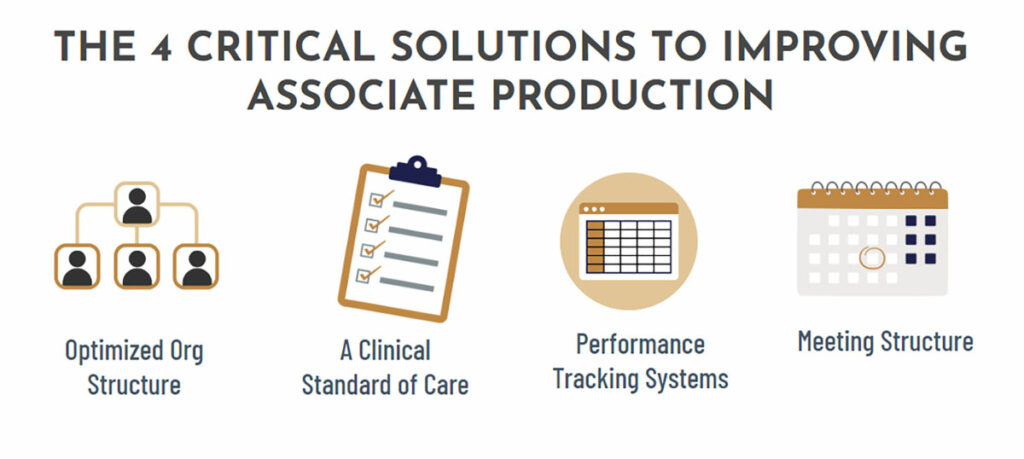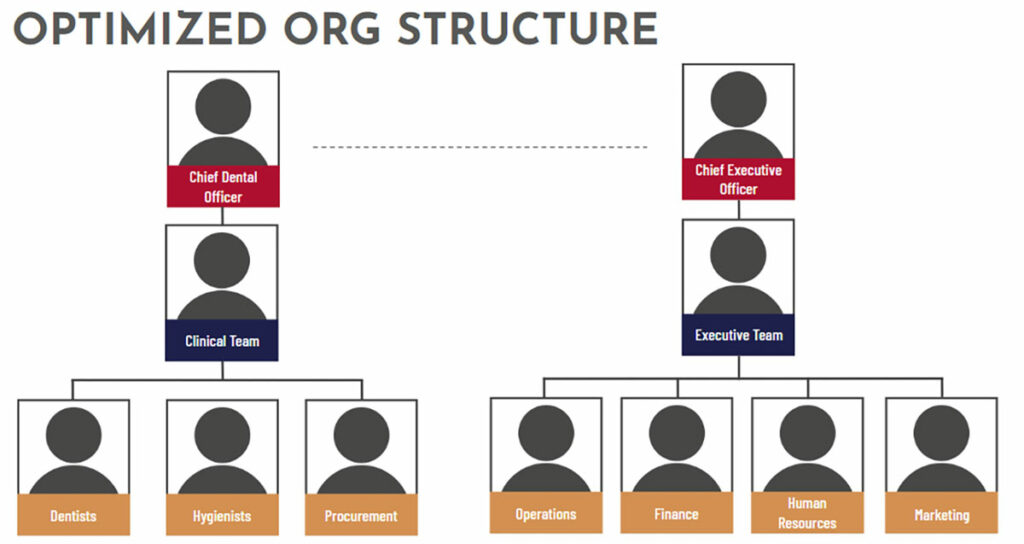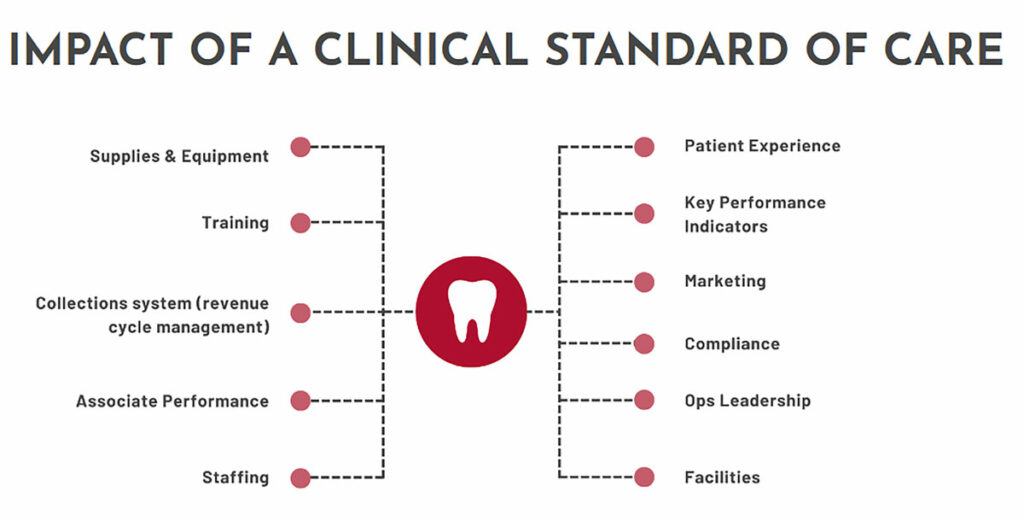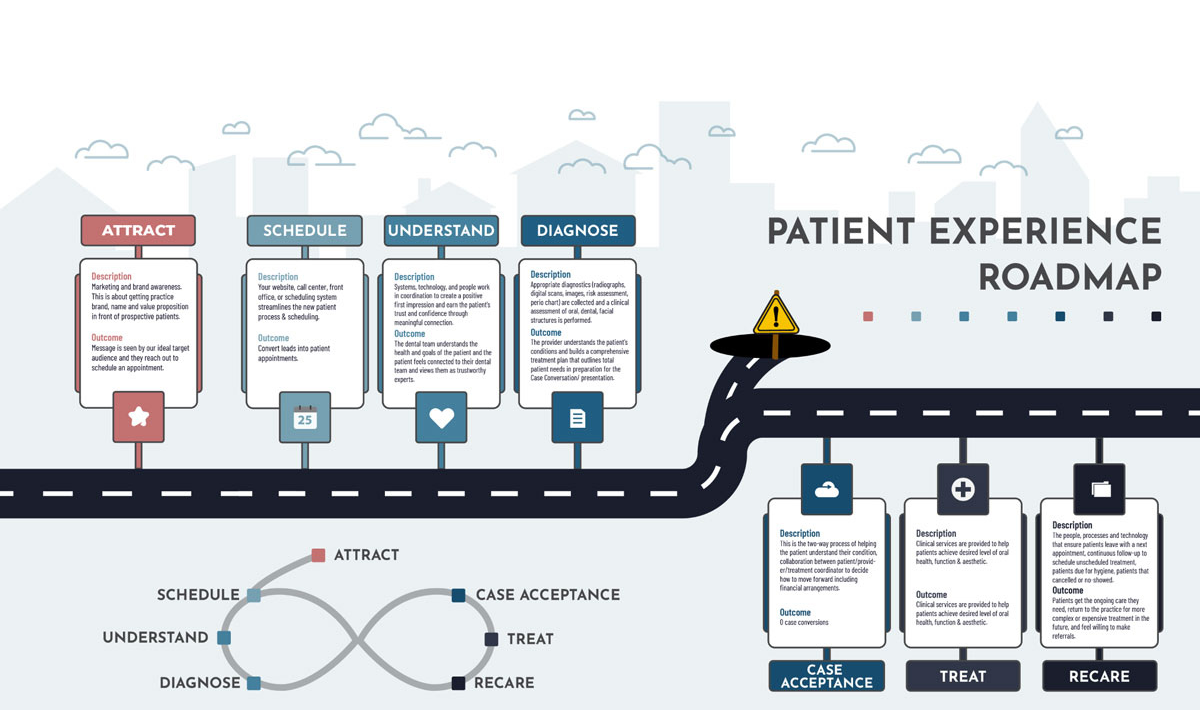How to develop a process that properly trains and tracks clinical performance.
Discussing clinical performance with your associates can feel a lot like talking politics. Things can get emotional and quickly go off the rails without the right preparation and structure.
Dental organizations must know how well their associates are producing, and address and train them if improvements are needed.
When looking into how to improve associate production, dental leaders must evaluate their treatment acceptance rate. Associates must always adhere to a clinical standard of care when conducting dental work, both to support associates and to cultivate more consistent production results.
In this article, leaders will learn how to create a clinical organizational chart that sets associates up for success, how to implement a clinical standard of care framework, and how to outline a clear process for tracking clinical performance and directing support in a dental organization where it is needed the most.
What clinical owners often get wrong
Sometimes, clinical owners don’t clearly identify which procedures they want done, or they don’t conduct reporting that compares associates to each other/there aren’t benchmarks to meet within the company. This results in associates not knowing who can assist them in improving their performance at work.
Other things that clinical owners often get wrong in managing associate production include:
- Don’t have reports that show associates compared to each other
- Don’t have benchmarks
- Don’t know who is responsible for improving the associate’s performance
- Don’t know how to navigate resistance from associates on taking accountability
To begin developing a training model for associates, clinical leaders should ask associates what areas they feel they excel at within the workplace, if they need help in their role, and what their supervisor or company does to help them perform at their best.

Critical solutions to improving associate production
Once leaders have a clear understanding of where each employee is professionally, they can begin developing a system for improving production. There are four critical solutions to improving associate production, including:
- An optimized organizational structure
- A clinical standard of care
- Performance tracking systems
- Meeting structure
Optimized organizational chart structures orient employees to a hierarchy. In dental, the Chief Dental Officer is the leader in charge. Make sure that the Chief Dental Officer is established as the highest within a clinical operating structure.
Then the larger vision or goal of the company should be communicated to associates by the CDO. This form of optimized clinical organization sets associates up for success and gives them a clear understanding of who their supervisor is, who they can go to with questions or concerns, and who is in charge within a company.

The impacts of establishing a standard of care will ripple through the entire organization. Standardization can be created for staffing, associate performance, supplies and equipment, marketing, compliance, etc. Leaders should aim to standardize any aspect of the business that needs clarity and organization.
Often, associates are not aware of what procedures they are supposed to follow. Leaders should clearly identify which procedures they want done and how they should be done. Leaders also must provide ways for associates to feel successful and ensure that they are doing tasks correctly. This means setting the right benchmarks and not avoiding difficult conversations with associates when needed.
Associates should know who is responsible for helping them improve their performance. Having a clinical standard of care framework, and a clear process for tracking clinical performance, allows supervisors to direct support where it’s needed the most.
Establishing a hierarchy within a standard of care additionally allows leaders to review marketing strategies and determine who the patient demographic is. Once a brand determines its audience, marketing responsibilities will flow into the operations and procedures within the company.
When building out a standard of care, start with the patient piece and determine how to organize the schedule to serve patients. Start with the associates who are managing patient contact and ensure that they have a clear understanding of scheduling expectations so that the front line of the business is already set up for success. Then, determine which procedures should take priority – such as knowing which ten procedures must get done, and in what order.
Finally, having a consistent meeting structure, with meetings both as a whole team and individual one-on-ones, allows for discussion of what improvements can be made in terms of performance. Meeting frequency with associates should include monthly/quarterly all-doctor training meetings and quarterly/biannual one-on-one performance review meetings.
| Building Your Clinical Standard of Care Patient Avatar • Which patients do you serve? • How will you organize your schedule to serve those patients? Clinical Capabilities • What procedures will you do? Won’t you do? • Which procedures take priority? Associate Contribution • What are your expectations for how associates will contribute to the patient experience? |

Patient Experience Roadmap
Patients come from a wide range of demographics, ages, and oral hygiene statuses. Some have insurance, and some don’t. Some patients consistently focus on their oral health, and some don’t visit the dentist at all. Determine what types of patients a practice is willing to take in, and also identify the types of patients that the business is unable to treat (such as a practice not being able to accommodate pediatric patients). Once the company has determined its avatar, tailor marketing to the exact demographic that you are trying to reach.
Once a patient demographic is determined, clinicians should figure out which procedure or operational capability would have the biggest impact if standardized and start from there. Having a performance tracking system formed within the context of patient needs tailors internal associate procedures toward the patient. Performance tracking systems provide documentation of which reports a dental business will run, how often, and how to drill down into the data of reports based on the clinical standard of care.
Within the patient experience roadmap, understand that the company’s clinical standard of care impacts every part of the business – from scheduling, understanding the patient, knowing what to diagnose, to how to organize comprehensive treatment plans. Use clinical ratios to benchmark each doctor, procedures by age group, or ratio of procedures such as fillings to crowns. Then, break data out by age group or insurance type.
Determining what “comprehensive” means to a practice, and what leads to case acceptance, includes understanding the acceptance standards, treatment goals, and the re-care piece of patient treatment.
For example, if hygiene is critical to the company’s success, associates should ask each patient before they leave a procedure if they wish to schedule another appointment. Even if a patient forgets to set an appointment, ensure there is a method of follow-up with those patients to get them back through the door.
Once a company has these established standards of care, leaders can recognize which staff members and dentists are performing their best, and which ones are falling behind and need to make changes to get caught up. Standardization can also get associates to a place where they feel comfortable saying that they need help and ask for guidance from managers. Managers can then help associates bridge knowledge gaps and get the associate on track toward personal and company success.
When implementing standardization, explain to associates and dentists that this is the new company vision, and that the new standards are how the business will establish the vision. This frames standardization as both mentorship and leadership that will help get associates to the next level. Measurements can include production per patient, breaking down care per visit type, how many patients are making re-care appointments, and which patients are electing same-day treatments. Standardization can be seen as an opportunity to look at the staff’s ratios for these procedure goals in relation to each other.
Clinical standard of care impacts every part of the patient experience – including patient retention, scheduling, diagnosis, re-care, etc. A systematic approach to evaluating an employee’s work is much more effective compared to saying that they aren’t performing well.
Standards are important as a company grows, as they allow employees to be driven toward certain achievable and trackable goals. They also allow supervisors to recognize when associates need help so that leaders can assist them through mentoring, leadership, and strategy to get the individual and the business performing at their best.





